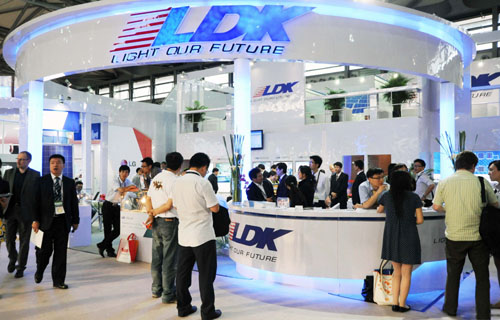Chinese companies have six months to raise share price to more than $1
Four Chinese solar equipment manufacturers have received delisting warnings from overseas stock markets, as orders shrink and profits slump.
LDK Solar Co Ltd, China's largest solar wafer manufacturer in terms of capacity, and a major producer of polysilicon and solar modules, informed its shareholders on Saturday that it received a notification from the New York Stock Exchange that it has to bring its share price above $1 within six months of Nov 5, or be delisted.
|
 |
|
LDK Solar Co Ltd's booth at a trade show in Shanghai in May. The share price of the Chinese solar equipment manufacturer, as well as those of Daqo New Energy Corp, Suntech Power Holdings Co Ltd and JA Solar Holdings Co, is currently less than $1. [Photo/China Daily]? |
The move on LDK follows similar actions made by the NYSE on Chongqing-based Daqo New Energy Corp on Aug 22 and Suntech Power Holdings Co Ltd on Sept 10 and by Nasdaq on JA Solar Holdings Co on Oct 11.
With net losses of $220 million in the second quarter and a debt ratio of 93 percent in the first half, LDK sold 19.9 percent of its shares to a State-backed company in late October.
Its share price surged by 21 percent on the day of the announcement, but still remained below $1.
Company representative Li Longji said there had been no major recent developments that would likely increase its share price.
But he told the 21st Century Business Herald on Tuesday that based on new investment and new orders, the company is resuming its idled production capacity, and around 70 percent of its total production capacity for silicon wafers has been restarted.
Suntech said on Thursday that it plans to cut two of its three production shifts in the United States and 50 jobs, blaming oversupply of solar panels in the global market and a tariff recently imposed by the US government.
Chinese solar companies have expanded aggressively in recent years.
Suntech's share price climbed to $88 in 2007, and LDK saw its price rise to more than $73 by 2009.
The installed capacity of solar power in China increased over the past decade, from 45,000 kW to around 3 million kW by the end of 2011.
The country has become the world's biggest solar equipment producer, accounting for more than 70 percent of global solar module output, with 90 percent of these made for export.
However, since the price of polysilicon dived in 2009, and the EU started cutting subsidies to the solar industry in 2011, Chinese solar producers have seen their profits slide, leaving excess production capacity across the industry.
The situation worsened in May after the US decided to impose heavy tariffs on Chinese-made solar panels, claiming that Chinese companies were dumping their products on the market. The European Union may also adopt similar duties later this year.
"These are tough times for the Chinese solar industry. Most companies are trying to cut costs by upgrading their technology, slash their payrolls or reduce output," said Zhao Yuwen, director of the photovoltaic special committee of the Chinese Renewable Energy Industries Association.
China's Energy Policy 2012, a government white paper issued last Wednesday, reaffirmed the government's commitment to fully developing the potential of solar power. It plans to increase its solar power generating capacity sevenfold by 2015, according to the white paper.
A key method of doing that is to allow photovoltaic solar power producers to connect to the national grid free of charge, in a bid to boost its sources of renewable energy.
China State Grid Corp, the nation's largest power grid operator, announced a series of measures in late October to facilitate the free connection of solar power plants to the grid, which experts hope will overcome a bottleneck that has stifled domestic demand for solar panels.
xieyu@chinadaily.com.cn
